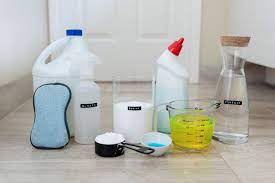In today’s fast-paced world, cleaning has evolved from a simple chore to a sophisticated process backed by science and technology. The modern cleaning industry is driven by a combination of research, innovation, and a deeper understanding of the materials and environments we interact with daily. Let’s delve into the principles that drive modern cleaning techniques, from the role of pH in cleaning solutions to the importance of dwell time.
The Role of pH in Cleaning Solutions
pH, which stands for “potential of hydrogen,” is a measure of the acidity or alkalinity of a solution. On the pH scale, which ranges from 0 to 14, a pH of 7 is neutral, values below 7 are acidic, and values above 7 are alkaline. The pH level of a cleaning solution can significantly impact its cleaning power.
- Acidic Solutions (pH < 7): These are effective at dissolving mineral deposits, rust, and other inorganic soils. They’re commonly used for descaling, rust removal, and toilet bowl cleaning.
- Alkaline Solutions (pH > 7): These are adept at breaking down fats, oils, proteins, and organic materials. They’re often used for degreasing, oven cleaning, and drain maintenance.
By understanding the nature of the soil or stain, professionals can select a cleaning solution with the appropriate pH level to effectively tackle the job.
Dwell Time: Why Patience Pays Off
Dwell time, also known as contact time, refers to the amount of time a cleaning product must remain on a surface to effectively do its job. It’s a crucial factor often overlooked in the cleaning process. For disinfectants and sanitizers, this time ensures that harmful pathogens are eradicated. For general cleaning agents, it allows the solution to penetrate and break down soils.
Ignoring dwell time can lead to subpar cleaning results. For instance, a disinfectant that hasn’t been left on long enough might not kill all harmful germs, compromising the safety of the environment. On the other hand, leaving a product on too long can sometimes damage surfaces or leave residues.
The Science of Surfactants
Surfactants, or surface-active agents, are the heroes of many cleaning solutions. They reduce the surface tension of water, allowing it to spread more easily and interact with oils and grease. This action breaks down and lifts away dirt from surfaces. There are four types of surfactants, each with its role:
Anionic Surfactants: Great for removing dirt and are commonly found in laundry and dishwashing
detergents.
Cationic Surfactants: Often used as disinfectants and fabric softeners.
Nonionic Surfactants: Effective in removing oily dirt and are found in many household cleaners.
Amphoteric Surfactants: Mild and versatile, often used in personal care products like shampoos.
Embracing Enzymatic Cleaners
 Enzymatic cleaners contain specific enzymes that break down organic materials like proteins, starches, and fats. They’re especially effective against stains and odors. For instance, protease breaks down protein-based stains like blood, while lipase tackles fat-based stains like oils.
Enzymatic cleaners contain specific enzymes that break down organic materials like proteins, starches, and fats. They’re especially effective against stains and odors. For instance, protease breaks down protein-based stains like blood, while lipase tackles fat-based stains like oils.
These cleaners are environmentally friendly, as they break down organic waste into water, carbon dioxide, and other natural elements. They’re particularly popular in healthcare settings, where they help break down bodily fluids.
Conclusion
The science behind effective cleaning is a fascinating blend of chemistry, biology, and technology. By understanding the principles that drive modern cleaning techniques, professionals can ensure more efficient, effective, and environmentally friendly cleaning outcomes. As we continue to learn and innovate, the future of cleaning promises to be even brighter, cleaner, and more sustainable.






























